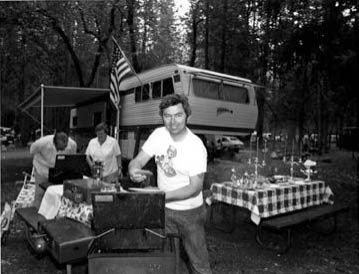|
|
|
 |
 |
 |
 |

Light & Ink
Bill Owens: Photographing the Suburban Soul
Interview by Robert Hirsch
(previous page)
RH: What about Photoshop?
BO: Photoshop is not in my vocabulary. I don’t need it because I have content. You need Photoshop when you’ve screwed it up.
RH: Would you use digital video in your new project?
BO: You know where I am going! I am going to be a documentary filmmaker. I’m flipped out over dovetailing the small image into the moving image back to the still images. It is also about sound. We lay our film out using iMovie and then go online and get music. Now I am making a mini film, 64 Degrees of Separation, for the New Orleans Museum of Modern Art.
RH: How much directing did you do?
BO: I have never directed much. Take the Tupperware party picture, there was no directing at all. I try and find the “right” position and pray the action unfolds in front of me.
RH: Will people devote the time to look at these mini films?
BO: I’m not going to worry about it.
RH: Do you still want to make books?
BO: Yes. A book is a physical object that you hold in your hand, carry around, and put on a shelf. The books on my coffee table include: Keeping Food Fresh, Germs, Medieval Kitchen, Generation Kill, The Power of Gold, Professor and the Mad Man, 1000 Years on a Hot Stove.
RH: Why the food books?
BO: I am doing a book on food because the photographs in the food magazines are too perfect. I am going to be the anti-Christ of food photography and show people the way that it really is. The first cut is done. It’s digital and fun.
RH: What about photography books?
BO: The only photography book is Motel Fetish (2002) by Chas Ray Krider. My favorite photographer is Yann Arthus-Bertrand, who did Good Breeding (1999), because he does his research and makes straight photographs of people and their animals.
RH: What previous work influenced Suburbia?
BO: I poured over Russell Lee’s Pie Town and the FSA images because they understood form. Everything has been done, but you draw inspiration. John Collier told me to open up the knife and fork drawer in people’s kitchen. I kept looking, looking, looking. I opened over 100 knife and fork drawers until I found the one I was searching for. All the symbols, from the corkscrew to the knives and forks, were there and properly arranged plus there is a toaster, an electric can opener, and blender in the background, and the counter is clean. This image was the result of studying those who came before me.
Every summer we go all out on our camp in Yosemite. I do the barbecuing. 1975
Bill Owens |
 |
 |
Sunday afternoon we get it together. I cook the steaks and my wife makes the salad. 1970
Bill Owens |
RH: Why did you switch to color in Leisure?
BO: Color offers another level of content, more texture, and more going on in general.
RH: Why did it take 30 years to complete your suburban project?
BO: I was married, had kids and responsibilities and couldn’t make a living in photography.
RH: I thought you would have made it.
BO: I had a slice of the pie, but advertising agencies weren’t interested in Suburbia. I may have documented the essence of the American soul, but advertisers didn’t want those kinds of images. I do not consider advertising pictures to be “photography”. When you are paid to do it, it’s not you; it’s them making the picture. They control what you want. Recently I did a New York Times assignment and it scared the crap out of me. They send you a shooting script telling you what they want, you provide that image, and that’s the end of that. It is work for hire. You can’t turn around and declare it is now suddenly art. There is a real difference between work for hire and what you see and respond to when you drive down the road.
(next page)
|
|
 |
 |
 |
 |
|
|
|